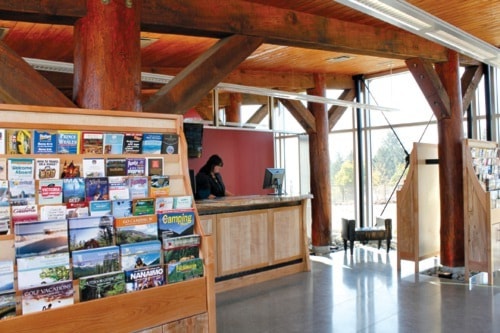The transformation of a picnic shelter to a tourist visitor centre on a busy stretch of Nanaimo highway seems like a natural fit.
But it wasn’t without its challenges.
The shelter, originally a Rotary project to provide a washroom facility for users of the Parkway Trail near Northfield Road, was designed by Raymond de Beeld and Shahrokh Khaze of Raymond de Beeld Architect Inc.
The pair wanted to incorporate both the history of the area’s mining heritage and the nature that surrounds it.
A grass-roof shelter with picnic tables and two washrooms, the area soon became popular as a rest stop and park-and-ride location for motorists.
“It became very busy but there was no electricity, no sewer just a water source and a holding tank for the washrooms had to be pumped out every couple of days,” said Ian Blackwood, city manager of facility maintenance and construction. “We eventually tied into the city’s sewer system about four years ago.”
The popularity of the site resulted in a plan for a Nanaimo Economic Development Corporation tourism visitor centre, but putting up a new building wasn’t possible so de Beeld and Khaze were called in to work with the footprint of the existing structure.
“It was a challenge, it was never intended to be closed in,” said de Beeld. “Tourism Nanaimo needed more space and we still had to make all the mechanical and electrical components required for a modern building fit. And we had to meet code. What was OK during the time of the shelter’s construction is not OK now.”
Keeping to the original intent and feel of the picnic area, the centre features glass walls to allow for views of the area.
A stream-like buffer of river rocks along the perimeter of the inside keeps visitors away from the glass walls and ties the inside to the outside.
The outside has garden beds and exposed aggregate concrete sidewalks to access the washrooms.
Khaze said the idea behind all the glass was to still get a sense of the original structure.
“The roof is still there, the wood beams are still there and whether you look at it inside or out, you still see the nature surrounding it,” he said.
Blackwood agreed the project was a challenge.
“Where it is built is a coal area so we had to remove the entire concrete slab where the picnic tables were and pour a new one engineered by a geotech,” he said.
The new building features a heated slab, a heat-pump system for heating and cooling and a polished concrete floor.
“The original grass roof still in place though it did get away from the city gardeners so they are going to replant it,” said Blackwood. “Some invasive plants have taken hold so it’s going to be put back to its original design. Typically you want plants that are drought tolerant in the summer, but also handle the wet winter months.”
The new centre has also helped with security.
“The problem before was there was no electricity so it was always dark,” said Blackwood. “Now we have electricity, floodlamps lighting up the area so it’s more secure.”
